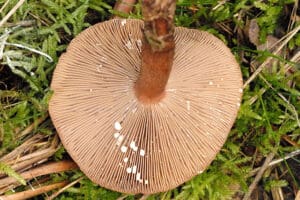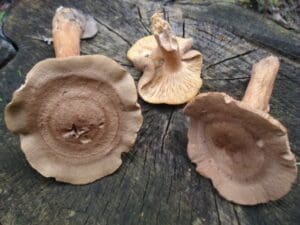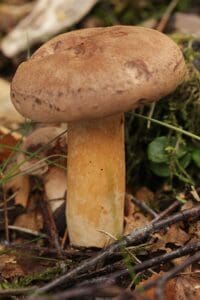Fenugreek Milkcap / Autumn / Winter / Toxic
The Fenugreek Milkcap (Lactarius helvus) is a striking mushroom that stands out not just for its appearance but for its unusual, spicy aroma reminiscent of fenugreek or maple syrup.
Found in acidic, mossy woodlands across the UK, particularly around pine trees, this mushroom might tempt us with its appealing scent—but don’t be fooled. Despite its culinary-like fragrance, this species is toxic and can cause serious health issues if consumed.
In this guide, we’ll delve into how to identify the Fenugreek Milkcap, where it grows, and why it’s essential to leave it where it stands.
Scientific Name
Lactarius helvus
Common Name
Fenugreek milkcap
Family
Russulaceae
Habitat and season
Mycorrhizal with pine, spruce and birch
This fungi favours a damp acidic habitat, particularly found in moss in Conifer and birch woodlands, and on moors and heathlands.
Can be frequent but is unevenly distributed, rare is central England. You’re most likely to find this mushroom in the north of the country where there is abundant moist, mossy conifer woodlands.
Summer to autumn.
Identifying Features of the Fenugreek Milkcap
Cap
Overall beige with tones of cinnamon and pinks. Convex to flat, sometimes ending up funnel shaped with depression and small central umbo.
5-15 cm across, matt, finely felty as the cap surface is covered in small flattered scales.
Cap margin is enrolled at first.

Stem:
3-12 cm long, cylindrical, spindle or club shaded at the base, finely felty and can have a hollow through the middle.
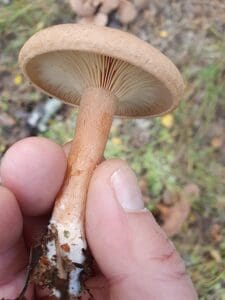
Gills:
Adnate to slightly decurrent. Pale to buff ochre
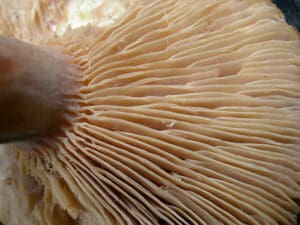

Flesh:
Off white
Latex/ milk
Clear, watery and sparse this is a distinguishing feature as this is the only UK species to have a totally clear milk.
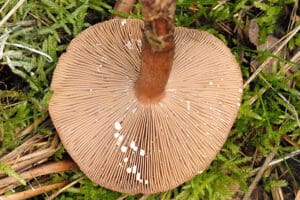
Smell
Of fenugreek or freshly mown grass, celery or maple syrup.
The mushroom contains sotolon which is also found in Loverage seeds, this is the chemical that gives it the characteristic odour.
Smell can be very mild when fresh, but strong when dried, some liken it to curry or stock cubes.
Taste is slightly bitter
Spores
White with a pinky ochre tinge.
Edibility/culinary notes of the Fenugreek Milkcap
Mildly poisonous raw, the toxins are destroyed after being well boiled.
In some countries the Fenugreek milkcap is boiled, dried and powdered then used sparingly as a curry flavouring, we would recommend leaving this one in case of incorrect cooking.
Fenugreek Milkcap Could Be Confused With…
This is the only Milkcap with completely clear milk
Visually other milk caps can look very similar but the smell and clear latex quickly differentiate.
Brittle gills (Russula) and some funnels (clitocybe) also look similar but non of these exude liquid when damaged so easily ruled out.
The below blog post may be useful:
An Introduction to Milkcap Mushrooms
Caution and known hazards
Consumed raw or under cooked can cause GI upset, chills and vertigo.
Extra Tips and Fun Facts
The Fenugreek milkcap was implicated in the poisoning of 418 people near Leipzig in October 1949
Resources
Nature-first.com
Edible mushrooms by Geoff Dann
Mushrooms by Roger Phillips
Fungi of temperate Europe by Thomas Laesson and Jens H.Peterson
https://en.wikipedia.org/wiki/Lactarius_helvus



